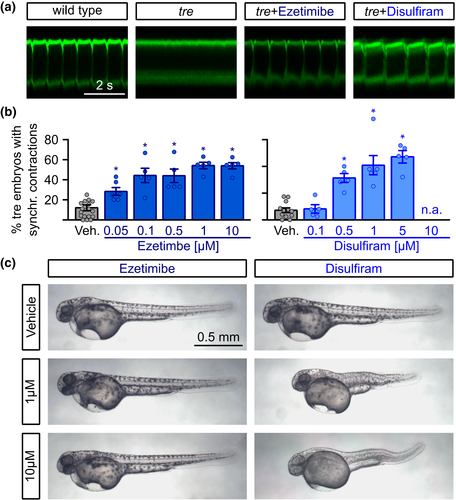Image
Figure Caption
Fig. 4
Restoration of rhythmic cardiac contractions in the zebrafish arrhythmia model tremblor. (a) Representative confocal linescan recordings through atria of beating GFP-labelled hearts from living zebrafish embryos (TG (myl7:eGFP)) at 1 day after fertilization. Rhythmic cardiac contractions can be observed in wild-type but not tremblor (tre) embryos. Treatment of tre embryos with 1 μM ezetimibe of 1 μM disulfiram restored rhythmic cardiac contractions. (b) Quantification of the percentage of tre embryos with synchronized contractions revealed a rescue of the tre phenotype from 11.1 ± 2.04% embryos with synchronized contractions in the vehicle control (n = 1289 embryos in 15 individual experiments) to 28.39 ± 3.9% of tre embryos at 0.05 μM (n = 155 embryos in six individual experiments), 44.07 ± 7.21% (n = 448 embryos in five individual experiments) after addition of 0.1 μM and a maximum of 53.85 ± 3.38% at 1 μM ezetimibe (n = 354 embryos in five individual experiments). While 0.1 μM disulfiram did not induce a significant effect (n = 507 embryos in five individual experiments), 1 μM disulfiram enhanced the percentage of embryos with synchronized contractions from 9.66 ± 2.31% (n = 1133 embryos from 12 individual experiments) to 54.27 ± 9.48% at 1 μM (n = 371 embryos from five individual experiments) and to 62.83 ± 5.6% at 5 μM (n = 418 embryos from five individual experiments) (Kruskal–Wallis test). (c) Treatment of zebrafish embryos with ezetimibe did not alter gross morphology of embryos, while disulfiram induced severe malformations of the body and a lack of pigmentation
Figure Data
Acknowledgments
This image is the copyrighted work of the attributed author or publisher, and
ZFIN has permission only to display this image to its users.
Additional permissions should be obtained from the applicable author or publisher of the image.
Full text @ Br. J. Pharmacol.

